Medical Service in Cambodia
Article information
Last summer, I went to Cambodia August 8 to 13, 2011 to perform medical service with the Korean Community for Medical Service in Cambodia (KCSC), an organization affiliated with the Soonchunhyang Medical Center. KCSC has been providing medical service in Cambodia for ten years. To mark the organization's 10th anniversary, service with the quality of a medium-sized hospital was provided by a group of Korean staff including professors from 12 departments as well as professor Yongbae Kim of the Plastic Surgery Department, residents, 35 church volunteers, Cambodian staff-including 20 physicians, and Koreans living in Cambodia (Fig. 1). An important factor contributing to the high quality of the service provided was the active participation of local Cambodian physicians who had been trained at Soonchunhyang Hospital.
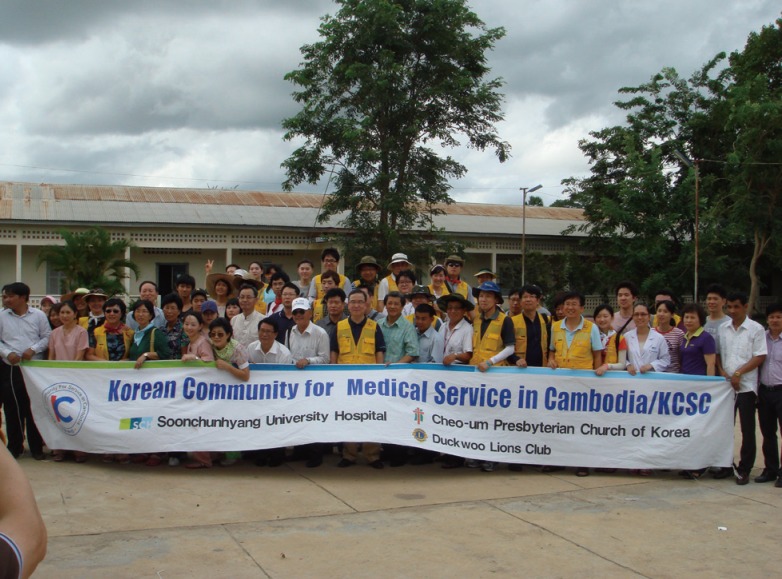
Leaving the hospital on the last day of medical service with Korean Community for Medical Service in Cambodia and church volunteers.
On our arrival in Cambodia, we struggled with feeling sticky because the humidity was much higher than what Koreans are accustomed to at home. After moving all the medical equipment to our lodging area, it was late, but we had a meeting to review our medical service schedule. Because almost one thousand patients were to receive treatment, after discussing methods for keeping order and guiding patients and cooperating with local Koreans, we were finally able to go to bed after midnight (Fig. 2). Early in the morning of the second day, we departed with our medical equipment for Kampong Speu Referral Hospital, which was located 50 km south of Phnom Penh, the capital of Cambodia. We had to put in a huge effort to deliver the medical equipment because we prepared fifty bags of equipment, each three times the size of an adult for the three day-service. Kampong Speu Referral Hospital was similar to the provincial hospitals of Gyeonggi province (the suburbs of Seoul), and the level of this hospital was excellent in Cambodia. Although the distance was not far, it took two hours to arrive there because of poor road conditions. The hospital was in a festive mood, like a field day. The Cambodian and Korean flags were raised. A governor welcomed us.
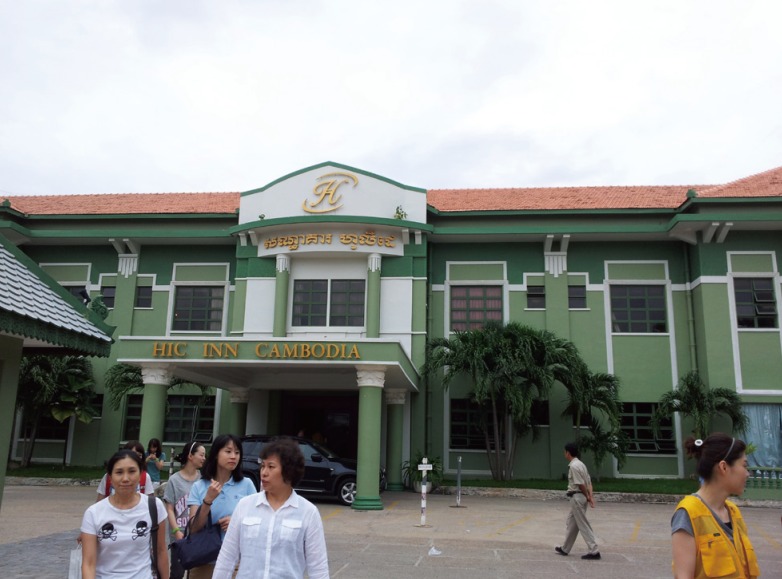
A view of the hotel where we had stayed. This hotel was in the middle of Phnom Penh, and the quality of the facilities was similar to motels in Korea. However, the hotel staff did help us a great deal in storing and moving our medical equipment.
It was like a marketplace because many people were already queued up outside of the hospital gate to see the doctor, and there were street vendors as well. The weather was still oppressively humid, but the patients stayed in line with the bread and water provided by the medical team in order not to lose their turns (Fig. 3). However, their faces were happy. It was a blessing that the rural residents were able to receive free medical treatment because Cambodian people live on less than fifty cents a day. Most people with diseases do not go to the doctor because they need to pay five or six dollars per visit.
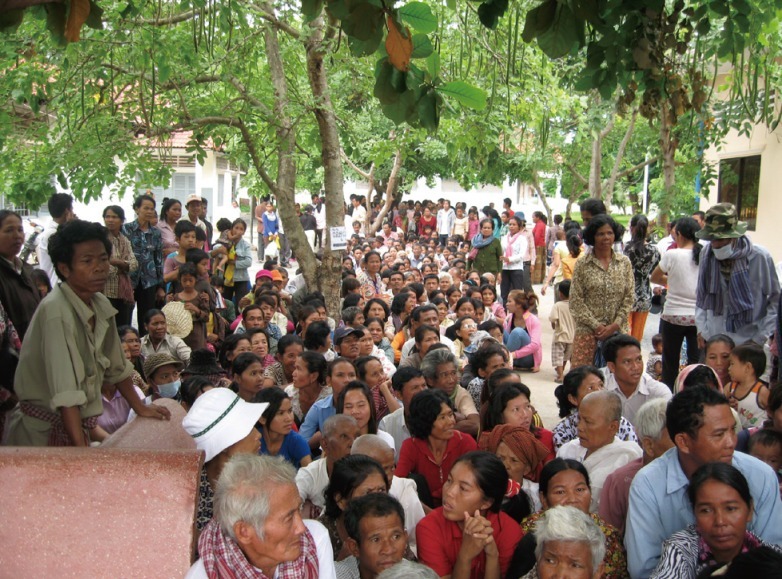
Cambodian patients queued up to wait for treatment. Although the weather was hot, we were able to provide medical service efficiently because they waited patiently.
Considering that the monthly wage of the middle class, like doctors and teachers, is fifty dollars, health care is unaffordable for ordinary people. The hospital was too small to serve the entire province. One-story buildings were arranged in a rectangle. There were only two buildings for outpatient clinics, one operating room, and six buildings containing patient rooms, each with no more than twelve beds. After moving the surgical instruments, we first checked the anesthesia equipment that we had donated earlier.
The machine was covered with dust and appeared as if it had not been used for years. We restored the machine to a usable condition by cleaning and replacing parts. There were already fifteen patients waiting for surgery even before we completed preparations. We hastily gobbled down a meal and started performing surgeries. Most patients had diseases that are rare in Korea, like congenital anomalies, huge masses, and extensive scar contracture. Most of them could be treated by procedures and operations on the spot. However, we sent back some of them, like a patient with a huge parotid mass with obvious evidence of malignancy and a No. 0 facial cleft with accompanying bony defect, or promised free treatment later in Korea, with funding for travel and expenses provided by our university. I felt sorry for them.
The most memorable patient was a two-year-old girl, the youngest daughter of a janitor of the hospital who earned fifteen dollars a month. The mother had never thought to go to the doctor when she or her children were sick because health care was too expensive. I was sorry that even an employee of this hospital had not been able to receive treatment for her children until our visit. I learned that her house was in a remote part of the countryside which was 7 km from Kampong Speu, but she and her husband worked cleaning the hospital, and her family, including her three children, stayed in a hidden corner of the hospital. Her daughter had a lesion that looked like a huge lipoma on her left buttock so that she could not sit. The mother's body language communicated how important it was to her that we help her daughter. The diameter of this lesion was over 10 cm, and it protruded about 4 cm, making sitting impossible. We performed an excision and local advancement flap right away, and the surgery was successful (Fig. 4). With a big smile, she tried to express her appreciation, telling us she would work hard so that her daughter could someday become a good doctor like the Korean doctors who helped her.
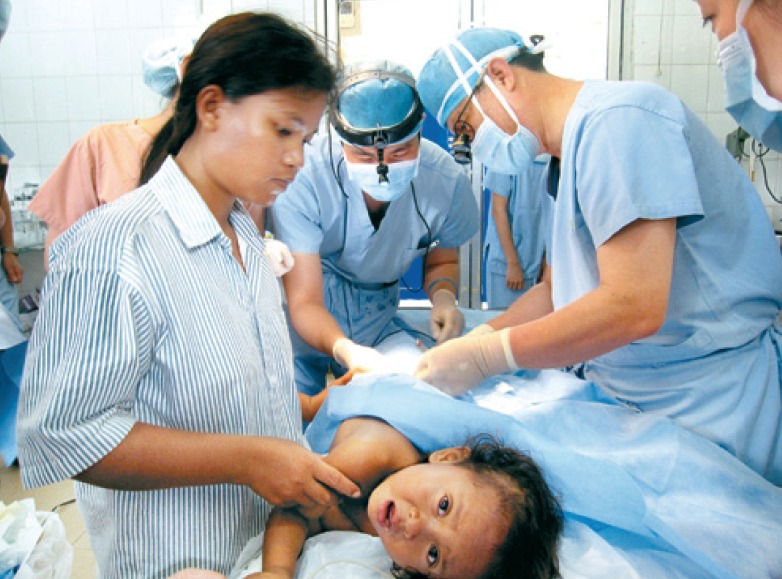
The janitor from the hospital and her youngest daughter, Professor Yong Bae Kim, and the author (Yim Don Choi). Picture provied by Maeil Business Newpaper.
Most of the 'operating' equipment was used only for general anesthesia because of the large number of surgical patients and poor medical devices in the operating room. Simple surgeries with local anesthesia were performed under headlights. Bleeding control was performed only by compression and hand tie because there was only disposable electrocautery equipment without cutting or coagulation modes. However, we did our utmost, more than any other surgery we had performed before in Korea (Fig. 5).
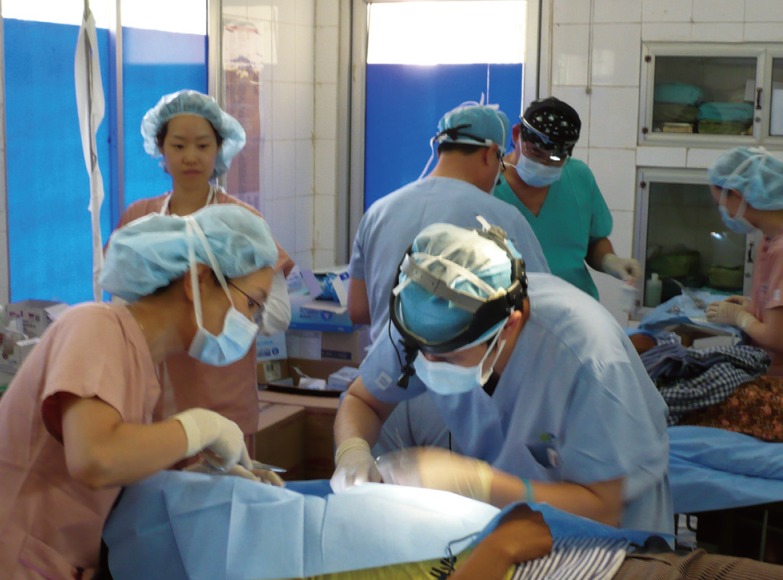
The view of the operating room. A room had two beds, and surgeries were performed in both beds at the same time. Local anesthesia and simple general anesthesia were administered by headlight.
On the third and fourth days, we were busy providing medical treatment and surgery all day long. Over the course of three days, we provided medical treatment for 3,224 patients and surgeries for 54 patients: 9 patients under general anesthesia and 45 patients under local anesthesia. One of the reasons we were able to treat so many patients was the help of the Cambodian physicians who had trained in our hospital for a year. Five physicians, including Dr. Buntharith, who had completed the plastic surgery training course in our hospital, closed their clinics and came to help us. When they had gone back to Cambodia after their training, I was sorry that I had not been able to help them enough, but I gained a new respect for them, seeing their progress in Cambodia and felt proud for them as well. They showed us their surgical cases proudly and asked for advice on various issues. They had clearly progressed after their training in Korea. On the last day of medical service, we held a conference with the Cambodian physicians who had been trained in our hospital (Fig. 6).
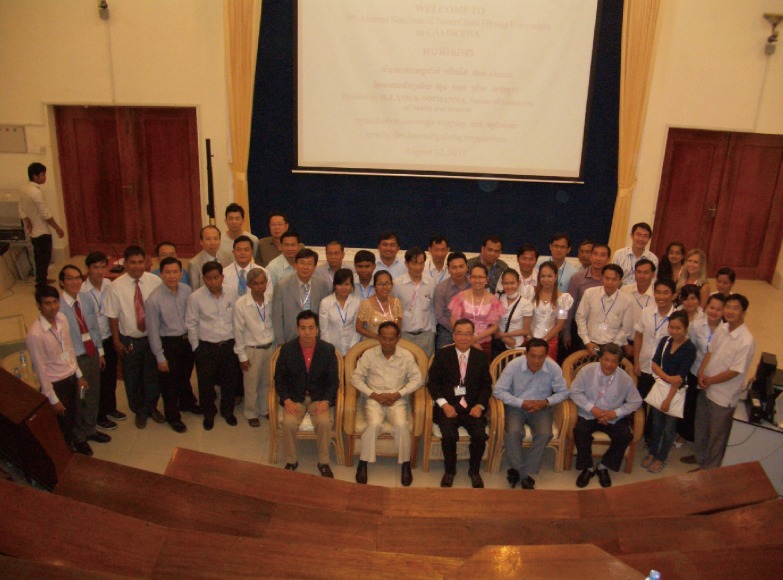
Soonchunhyang and Cambodia conference on the last day of our volunteer work. The Cambodian physicians who had been trained in Soonchunhyang Hospital had made great progress.
In addition to those in plastic surgery, the other physicians who had been trained in other departments had also progressed in their skill. Notably, Dr. Ivecheth who had been trained in the Neurosurgery Department had created the independent medical specialization of neurosurgery in Cambodia. I thought I needed to help them so that plastic surgery would also be separated into an independent medical specialization.
Although I have participated in several medical service trips, this experience left a deeper impression on me than the others. This time, I had been very busy before the trip, so the medical service gave me a chance to center myself and settle down. It felt really great to help people who needed medical treatment but could not receive it. Medical service trips are planned only one or two times a year; however, we can continue to help Cambodian physicians advance the development of medical treatment in Cambodia by training them while we work in Korea. Thus, this training is really meaningful, and I think I am able to serve them every day by helping with it.